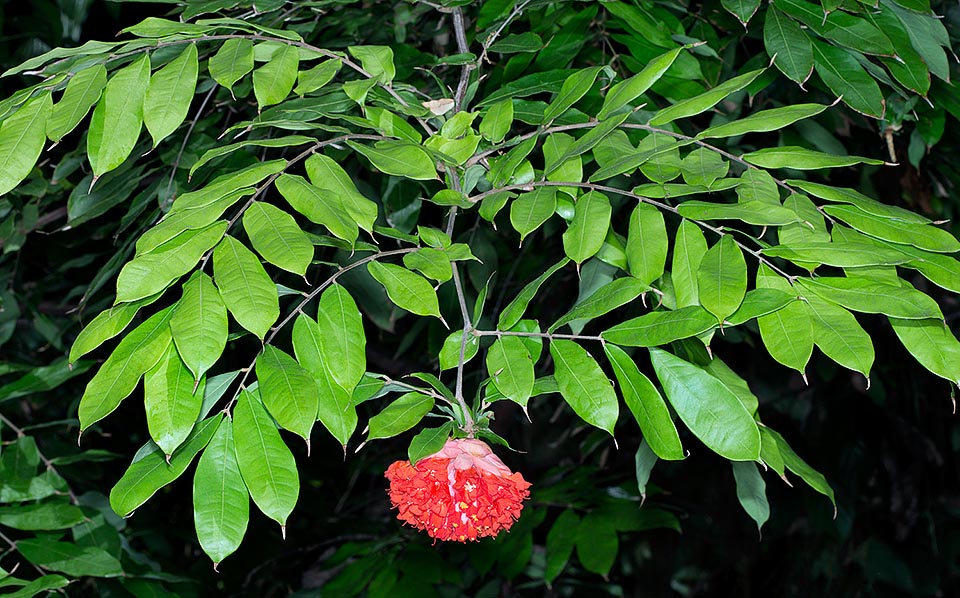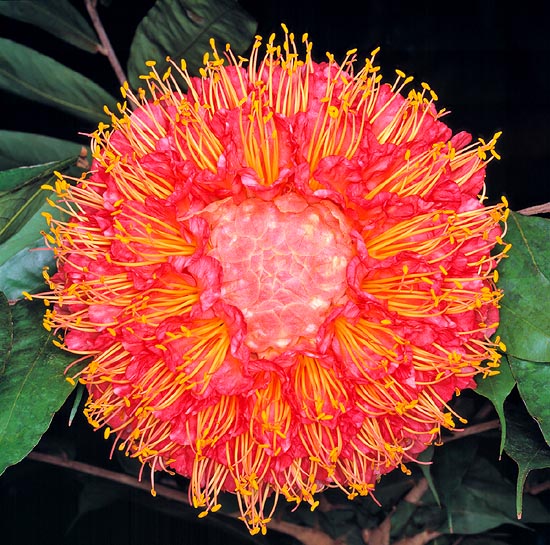Family : Fabaceae

Text © Pietro Puccio

English translation by Mario Beltramini
This species is native to Colombia, Ecuador, Peru and Venezuela (Aragua, Carabobo, Federal District and Yaracuy), where it grows in the forest of the Amazonian region at low and medium altitudes.
The genus is honoured the Irish botanist Patrick Browne (1720-1790); the name of the species is the combination of the Latin adjective “grandis” = big and the suffix “ceps”, form coming from the Latin “caput” = head, with reference to the globular inflorescence.

Native to Colombia, Ecuador, Peru and Venezuela the Brownea grandiceps is a slow growing evergreen that reaches the 10 m of height © Giuseppe Mazza
The Brownea grandiceps Jacq. (1789) is a slow-growing, medium-sized tree, up to about 10 m tall, evergreen, with rigid descending branches. The leaves are paripinnate, alternate, 10-45 cm long, hanging, with 4 to 16 pairs of lanceolate or oblong pinnulae with sharp tip, of pale green colour, 6-15 cm long and 2-3 cm broad; the young leaves are grouped, hanging, of a brownish colour marbled of purple pink and greenish white.

Is considered one of the most ornamental trees due to the big 20-25 cm inflorescences © G. Mazza
The inflorescences hanging at the extremity of the branches, are globular, panicle or heads of 20-25 cm of diameter, with numerous 5-8 cm long flowers, strictly close each other; the single flowers have 5 obovate petals of about 4 cm of length and 2 cm of breadth, of intense pink or red colour, which open in succession starting from the outer ring.
The fruits are 25 cm long brown flat pods, covered by a fine down, and containing 1-4 oval seeds, about 4 cm broad and 1,2 cm thick, of grey colour.
It reproduces by seed and by air layering; the seed must be placed in the soil in a short time, 1-3 weeks from the harvesting, as it has a short-lasting germination power, in a substratum rich of organic substance with addition of sand at around the 30% at a temperature of 22-24 °C; the germination usually takes place within 1-2 months.
It is considered as one of the most ornamental trees due to its large inflorescences, but also due to the typical structure and colour of the new vegetation; it is cultivable in the tropical climate zones and also, marginally, in the subtropical ones, where it may resist to exceptional and quite short temperatures close to the 0 °C.
The adult plants grow up well in full sun, whilst a slight shade is better for the young ones. The substratum must be permeable, rich of humus and kept constantly humid during the vegetative period, allowing the surface layer to dry up during the vegetative rest. In the locations where the open air cultivation is not possible, it may be cultivated, in roomy containers, in large luminous greenhouses, utilizing soil rich of humus with the addition of sand for a 30%, to temperatures over the 12 °C in winter; the watering must be abundant and regular in summer, moderate in winter. Parts of the plant are variously utilized in the traditional medicine, in particular the bark which contains a powerful haemostatic.
Synonyms: Hermesias grandiceps (Jacq.) Kuntze (1891); Brownea amplibracteata Pittier (1945); Brownea araguensis Pittier (1945).
→ To appreciate the biodiversity within the family of FABACEAE please click here.
